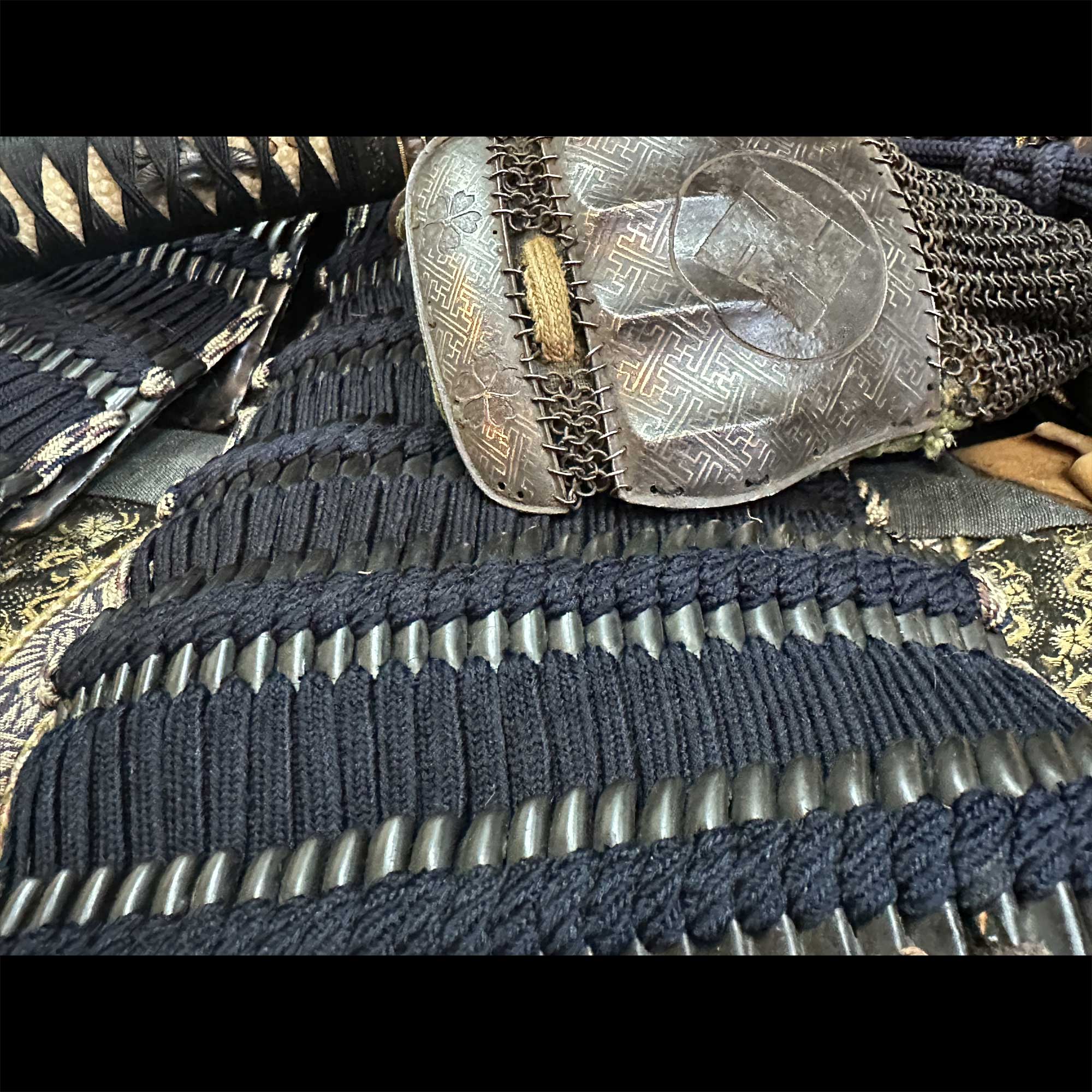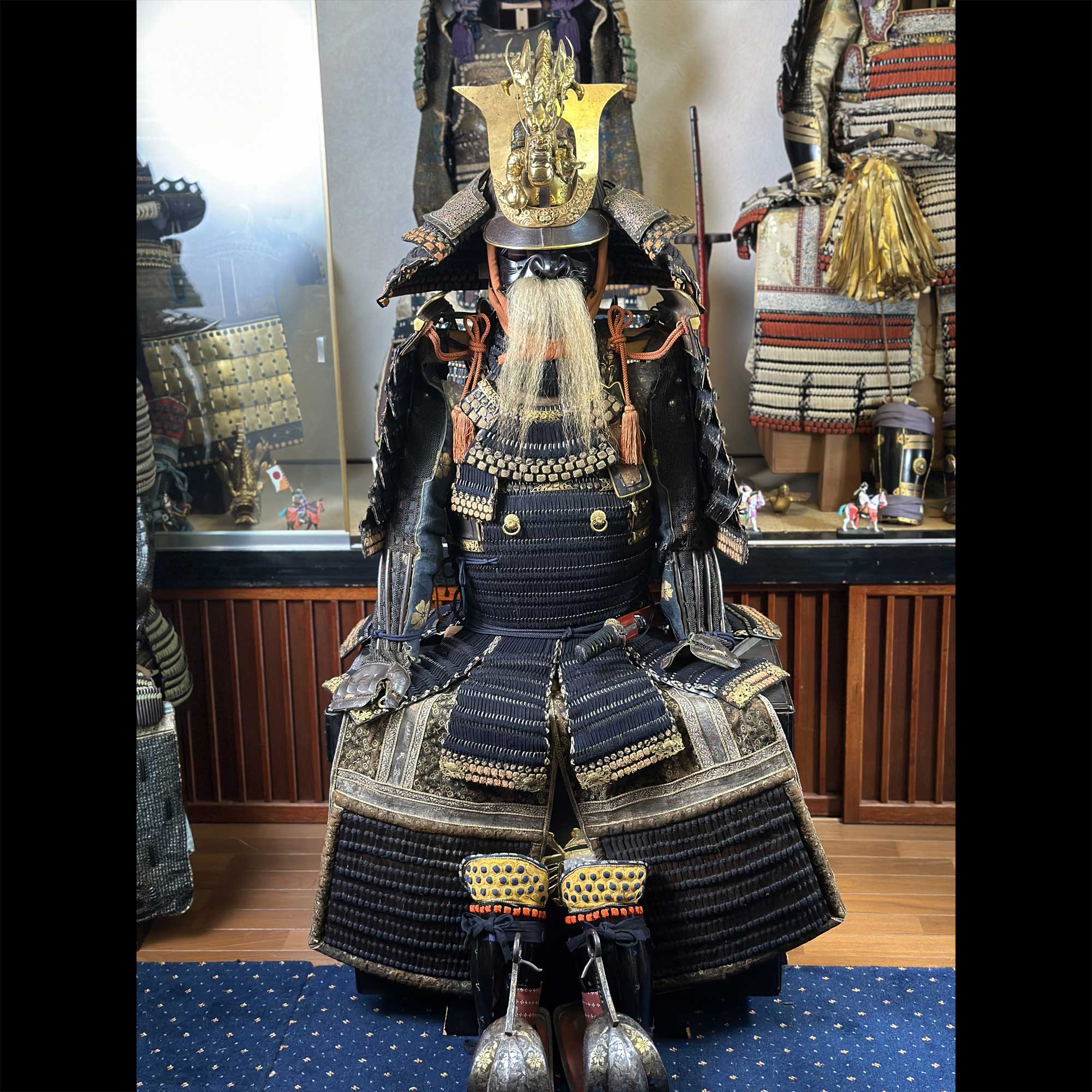

Honkozane Konito Odoshi Domaru Japanese Armor
We are very sorry for the inconvenience caused by the last time auction unable to bid in some areas. We will re-list the items for bidding in a wider range of areas. Thank you.
This suit of armor was introduced on Japan's BS Asahi program, 'Inherited Divine Techniques: Japan Traditional Craft Art.' This show showcases master artisans (maestros) who inherit Japan's traditional culture and techniques. The program was broadcasted to broadly recognize and document the traditions of artisans, including historical, cultural, and technical aspects, that they pass down.
Armor, known as 'kacchū' in Japanese, is the attire worn by samurai when facing the battlefield. This attire represents the status, prestige, and authority of the warrior. The samurai armor, as attire, has been considered an artistic work symbolizing the warrior culture and has been passed down through the hands of artisans in Japan from the 10th century to the present 21st century.
In Japan, there is the 'Sōma Nomaoi' festival, which vividly conveys the image of brave warriors to the contemporary era. It is said to have originated from the early brave general, Taira no Masakado, who left a mark as a samurai in Japanese history. For a thousand years, the 'Sōma Nomaoi' festival, where participants wear armor symbolizing the warrior culture and parade through the streets, reminds us of the valiant warriors of the past.
In the central location of the 'Sōma Nomaoi' festival, Minamisōma City, Fukushima Prefecture, there is a workshop established by Mr. Abe Mitsuo of the Iwai school, one of the few in the country to inherit the traditional techniques of crafting armor.


Having apprenticed under Mr. Yoshihiko Sasama, a foremost historian of armor and weaponry during that time, Mr. Abe acquired top-notch knowledge and skills as an armor craftsman. Recognizing his proficiency, and with the revival of the Iwai family of armor craftsmen in mind—an art that had been dormant since the Meiji era—he was bestowed the name "Iwai Mitsutomi” by his mentor, Mr. Yoshihiko Sasama.
Now the sole legitimate modern armor craftsman of the Iwai school, Master "Iwai Mitsutomi," transcending the moment when divine skill was infused into the armor, carries forward the dignity of life and the honor of a samurai.
The restoration of "Honkozane Konito Odoshi Domaru" by Master Iwai Mitsutomi from the Iwai school, a repair of work by the Myochin school, is a remarkable piece. Amidst the prevalence of lightweight replica works, this armor, meticulously repaired entirely by hand using carefully selected traditional materials, revives the spirit of armor craftsmen from the 17th century (Edo period) in the modern era.
This suit of armor, belonging to the Myochin school, one of the five schools of armor craftsmanship, underwent restoration by Iwai Mitsutomi, the inheritor of the prestigious Iwai school and the most esteemed contemporary armor craftsman. The Iwai school, favored by the Tokugawa shogunate that dominated Japan for nearly 300 years from the medieval period, holds a position of great distinction among the armor schools. It can be said to be a one-of-a-kind masterpiece in the world, a work endowed with history and elegance.
More than 3000 components were meticulously assembled by Iwai Mitsutomi over many years with great dedication. From this suit of armor, worn into battle, you should feel the dignity of the samurai, the sanctity of life, and the spirit of the craftsman who weaves the armor together, speaking to you.
For the individual who appreciates and understands the sentiments passed down through generations from the 17th-century warrior who wore this armor, we wish to entrust this piece to the next generation, the next century. The desired bidding price is 100 million yen.
Product Features


The history of armor in Japan is quite ancient. Wooden armor from the Yayoi period has been excavated, and over time, both the technology and forms of armor have evolved. The organization of craftsmen, known as armorsmiths or "kacchu-shi," began in the Edo period. They were employed by daimyos and other feudal lords to produce armors for their clans, and these artisans became known as "Oie-ryu." The five major schools that have been passed down to the present day are the "Haruta-ha," “Myochin-ha," "Saotome-ha," "Iwai-ha," and "Yukinoshita-ha." Among them, a contemporary armorsmith who follows the tradition of the Iwai school is Mr. Mitsuo Abe.
The Iwai school became one of the most prestigious schools of armor craftsmen during the Edo period. Enjoying the favor of the Tokugawa family, they were responsible for crafting armor. They undertook the repair and restoration of precious armor, some of which are now designated as national treasures. Notable examples include the ancient armor of Kasuga Taisha Shrine in Nara, the ‘Kurokawa Odoshi Domaru' of Itsukushima Shrine in Hiroshima, and the ‘Kozakuragawa Kigaeshi Odoshi Oyoroi' of Sugata Tenjin Shrine. The Iwai school is regarded as a distinguished lineage among armor craftsmen, having excelled in the repair and preservation of valuable armors that are now national treasures.


Japanese Armor is composed of over 3,000 parts, meticulously crafted from materials such as leather, iron, braids, rivets, lacquer, and engraving, intricately assembled to form a complete suit. The scope of work spans a wide range, depending on the areas requiring repair and the construction details.
Armor that has transcended history naturally undergoes deterioration, and it is not uncommon to dismantle the entire suit to repair a single part. As an armor craftsman, it is impossible to perform repairs without a broad knowledge of various schools and traditional techniques. The ability to revive the spirit of armor craftsmen from the Edo period, spanning over 400 years, is attributed to the meticulous selection of rare materials, unwavering dedication, spending an immense amount of time engaging with each piece of armor, and the soul of a master craftsman who answers each challenge with divine skill. Through this clash and fusion, the craftsman breathes life into the armor, elevating it to a unique and unparalleled existence.
The fusion of history and divine skill can truly be considered the essence of authentic value.

Development Story
Mr. Mitsuo Abe was born and raised in Minamisoma City, Fukushima Prefecture, during the turbulent post-World War II era. While assisting his father's ironworks, he acquired various metalworking and technical skills. Growing up in an area known for the "Soma Nomaoi" festival, he often received requests for armor repairs, leading him to decide to pursue the path of an armor craftsman around the age of 40.
At that time, he apprenticed under Yoshihiko Sasama, a leading expert in the field of armor and weaponry history. Under Sasama's guidance, he began honing his skills and expanding his knowledge as an armor craftsman. Recognizing his proficiency, he was entrusted with the revival of the Iwai school, a lineage of armor craftsmen that had ceased to exist since the Meiji era. Bestowed with the name "Iwai Mitsutomi,” he emerged as a modern armor craftsman of the Iwai school— Iwai Mitsutomi (Mitsuo Abe).
Walking the path of an armor craftsman for 40 years, Mr. Abe has faced challenges such as the loss of his warehouse, which stored historical items like armor and weaponry, swept away by the tsunami during the Great East Japan Earthquake. Despite these difficulties, he resonates with the history of Sōma and expresses his commitment to diligently fulfill his work, continue researching and studying, and pursue his path as an armor craftsman until the end of his life. He speaks of overcoming these challenges and articulates a strong determination to persevere in his craft.
Get a supreme product of master craftsmen!
Precautions for use
[Important Information]
This piece is not crafted with contemporary materials for modern individuals; instead, it is a restoration of a genuine item created in the past by a contemporary master armor craftsman. Therefore, the following points should be considered in its handling and maintenance:
* Horse equipment is not included.
* The armor primarily uses leather/iron/cloth/silk thread/lacquer as the main materials.
* We repair and preserve, leaving some dirt, minor scratches, and cracks as they add to the historical charm, as long as there are no functional issues.
* The wakizashi (side sword) is a decorative item and is a replica.
* Please refrain from using camphor, as it might cause degradation of the leather and corrosion of the iron.
* To prevent deterioration, ensure temperature and humidity control and store it in a place with minimal temperature fluctuations at room temperature.
* Avoid places with direct sunlight to prevent fading of cloth and thread colors.
* Prolonged placement in hot and humid areas may cause lacquer to crack.
* Maintenance involves dry wiping with a cloth; do not use chemical detergents or glossing agents.
* Silk threads may deteriorate after approximately 200 years, and repairs may be necessary.
* Transportation will be conducted using a dedicated armor box for art transport; refer to the video for assembly instructions for display.
* If repairs become necessary, we are willing to undertake them, provided you cover the round-trip transportation costs.
* A certificate will be provided for the restoration of "Honkozane Konito Odoshi Domaru,” a work by the Myōchin school, restored by Mitsutomi Iwai of the Iwai school, a contemporary armor craftsman.
[Disclaimer]
Our company shall not be liable for any damages, for any reason whatsoever, in cases where it is stipulated in these terms and conditions that the company is not responsible.
1. If there is a significant difference between the bidding price set by the company and the actual winning bid price, resulting in a profit or loss, no sales contract will be concluded.
2. In the event of damages caused by natural disasters, geological changes, war, disturbances, nuclear fuel materials, or acts of dispute, our company shall not be obliged to compensate for any damages.
3. In cases where our company assumes the obligation to store the products for the successful bidder, except as provided in the preceding items, if the products are destroyed, lost, stolen, severely damaged, or soiled due to our company's slight negligence, the following provisions shall apply in the relationship with the successful bidder:
- If the products are lost, stolen, severely damaged, or soiled, the sales contract between our company and the successful bidder shall be automatically terminated. The successful bidder shall be exempt from the payment of the purchase price, and if our company has already received the purchase price, it shall refund it without interest.
- In the case of minor damage or soiling, our company will reduce the purchase price by a percentage corresponding to the amount of damage or soiling in relation to the sales price (winning bid price).
- The successful bidder bears the burden of proof for damages or soiling.
- Our company assumes no storage responsibility for frames and glass, except in cases of intentional or gross negligence by our company, and shall not be liable for loss, theft, severe damage, destruction, or soiling.
- The number of damages our company pays according to this section shall be paid based on the damage insurance contract concluded by our company with the insurance company. The insurance money shall be used to cover this.
- In cases other than those stipulated in the preceding items, even in the event of intentional or gross negligence by our company, the scope of liability for damages is limited to the extent of foreseeable damages at the time of intentional or gross negligence, beyond the normal damages.

























































































